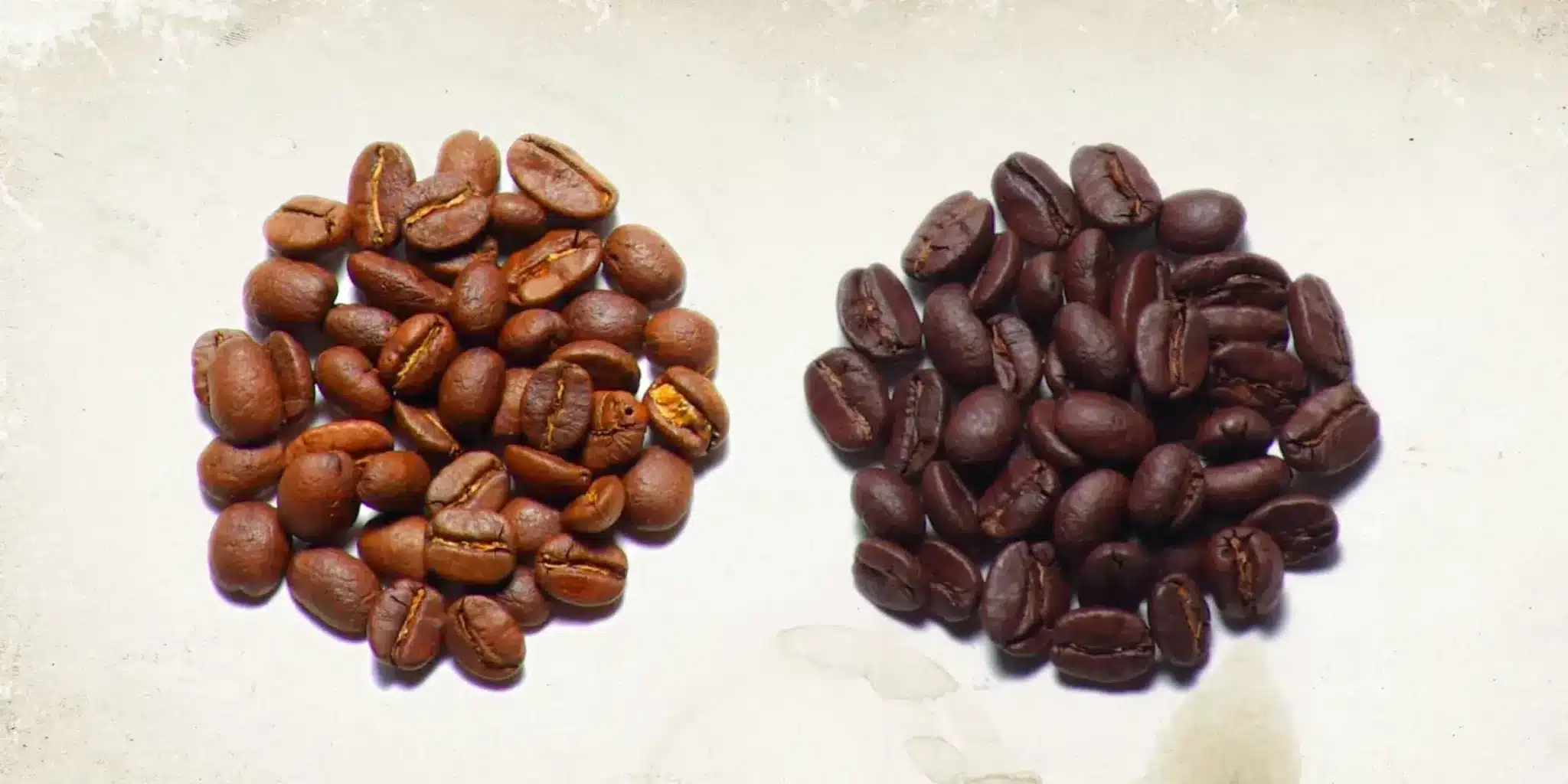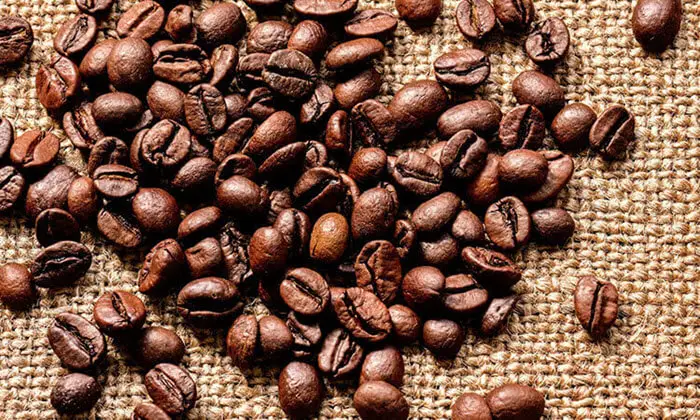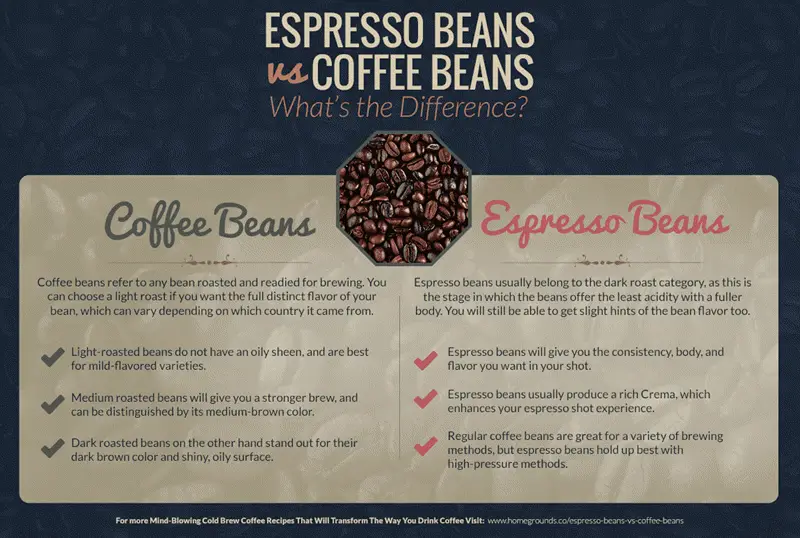Walking down the aisle in the grocery store, your eyes might go through Espresso, and your mind might wonder what the difference between coffee beans and Espresso beans is?
So here it is. It’s all about the way it is brewed!
So in this article, we will discuss the difference between Espresso vs coffee beans, how they are roasted, and the burst of flavors they produce.
Table Of Contents
What are Espresso Beans and Coffee Beans?
Coffee Beans
The coffee beans are dark and roasted for a longer time than the medium roasted beans. They are a more roasted flavor compared to the nuanced character.
As the black coffee is roasted, different colors from green to brown to black are seen. However, you will only feel the burnt taste at the black point, whereas brown shows a rainbow of flavors such as chocolatey, warm, and sweetness like caramel.
So, in this way, they are categorized as short-term roasted, which are lighter in color, than long-term roasted, which are pretty dark.
Espresso Beans
Here comes the New cool. These espresso beans are members of the dark-roasted family.
There is a minor level of acidity in the beans, and it will give you a flavorful blast too! It is exquisitely rich in the oily sheen of coffee, adding shine to its body. You will have a lick of it.
There is a misconception that Espresso is made from different coffee beans. However, the reality is it is made from the same beans, but the grids and brewing method make it distinguished.
Most people widely love espresso coffee due to its dark-roasted taste. This makes it pretty popular in the family of coffee beans.
Bonus: if you prefer Espresso powder, check out this post to find the best Espresso powder for drinking or baking.
Coffee Beans Vs. Espresso Beans: What’s the Difference?
After reading up till here, you might probably think, is Espresso the same as coffee?
So, the answer is no.
Let’s look at the differences among them.
Image from the HomeGrounds
1. Roast
Espresso beans are roasted for a more extended period and thus are darker than coffee beans.
The medium or medium to dark is the coffee drips. Expresso is roasted to such an extent that it eradicates all the acidity, and you feel fullness in your mouth. I am an avid fan of Espresso due to its energizing power.
So, if you see Espresso written over the packet of coffee, it should strike your mind that it is roasted the greatest.
2. Grind
Espresso meets the finest grind.
This is because it is passed through hot water in the tightly-packed grounds, so refined grains occur, as smooth as sand. After all, the water touches for a brief time.
If any coffee packet has Espresso written, it simply means that it is finely grinder to the level of Espresso. This coffee is best used for skincare and haircare routines, as it has less harmful impacts on the skin.
3. Brewing
To sip a regular hot cup of coffee, you can use methods such as the french press, percolator, or drip.
However, Espresso requires a unique brewing method, commonly known as Aeropress or espresso machine that produces highly concentrated Espresso. The original and authentic espresso taste you crave cant be made by using the standard method as high pressure is required.
Feeling it’s a stricter method?
No, it’s not! Once you learn how to make espresso coffee, then let it be any time of the day, morning, evening, or night. You are just a few minutes away from your hot fresh cup of hot coffee.
You make like: Best Coffee Makers for Hard Water
4. Taste
Expresso has a delicate exquisite taste differentiated from the regular coffee drip. It possesses a less acidic and bolder flavor. It has a better, fully finished taste.
The roasting releases oils from the coffee, which accounts for the heavier taste and more fullness.
The bitterness that you crave is found in the shot of Espresso due to its long roasting, which your whole cup of coffee might lack!
5. The Richness of Oil
Espresso takes the credit here, as, during the brewing process, it produces a high amount of caffeine, whereas coffee beans, though they possess the same shine, have no oil storage in them.
6. The Concentration of Coffee beans vs Espresso.
Coffee beans have medium to light concentration as it is roasted for less time and ade over less pressure. However, Espresso is quite intense in concentration. It is the pure coffee flavor that you crave.
In fact, at times, it is so concentrated that you might need to add water to dilute it.
7. Size and Density of both Beans
When a coffee bean is roasted, it loses weight as pure threads of coffee are left inside it.
Moreover, on the other hand, it makes them more prominent too. So, Espresso is more extensive and less dense than regular coffee beans.
8. The Caffeine Content in Espresso vs. Coffee Beans
This is an ancient myth that Espresso holds more caffeine than coffee beans. But the case is oppositely genuine!
This is because, during a long-term roasting, a lot of caffeine in Espresso is burnt out, which makes it caffeine-free!
However, one fact to be kept in mind is that 1 ounce of Espresso has caffeine equal to 8 Ounces of regular coffee beans, so be sure as you make a cup.
Make sure you don’t overdose on caffeine!
Conclusion
I hope you got the idea of the difference between espresso and coffee beans.
They are both made from the same plant, coffee; however, the difference is mainly in roasting and brewing. But one thing to remember is that espresso can be brewed into any coffee; however, the coffee beans cant produce the exotic Espresso.
So, depending on your taste, you can either go for a more robust and more prosperous espresso coffee! Or sip your tongue with the medium-sweet taste of coffee beans!




